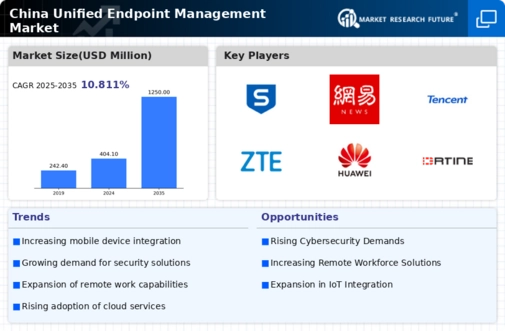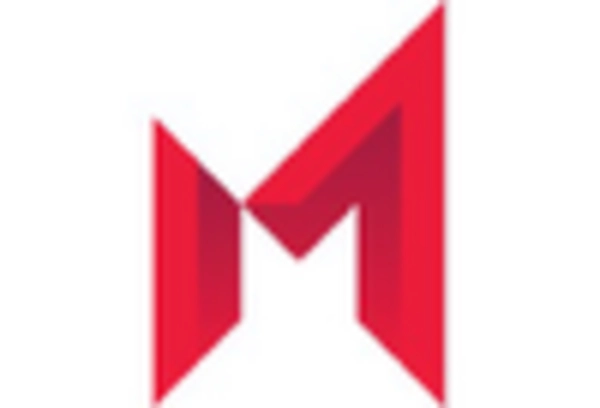Integration of IoT Devices
The integration of Internet of Things (IoT) devices into business operations is reshaping the landscape of the unified endpoint-management market in China. As organizations adopt IoT technologies to enhance operational efficiency, the need for effective management of these diverse endpoints becomes paramount. The number of IoT devices in China is projected to exceed 1 billion by 2025, creating a complex environment that requires unified management solutions. This trend is likely to drive the demand for endpoint management tools that can seamlessly integrate and secure IoT devices alongside traditional endpoints. Consequently, the unified endpoint-management market is expected to experience substantial growth, with forecasts indicating a market size of around $1.8 billion by 2026.
Rising Cybersecurity Threats
The escalating cybersecurity threats in China are a significant driver for the unified endpoint-management market. With an increase in cyberattacks targeting businesses, organizations are compelled to adopt comprehensive security measures to protect their endpoints. The unified endpoint-management market is responding to this need by offering solutions that provide enhanced security features, such as threat detection and response capabilities. As businesses recognize the importance of safeguarding their digital assets, investments in endpoint management solutions are expected to rise. The market is projected to reach approximately $2.2 billion by 2026, reflecting a growing awareness of cybersecurity risks and the necessity for robust endpoint management strategies.
Surge in Mobile Device Usage
The proliferation of mobile devices in China is a key driver for the unified endpoint-management market. With an estimated 1.6 billion mobile subscriptions in the country, organizations are increasingly adopting mobile device management solutions to secure and manage these endpoints. This trend is further fueled by the rise of mobile applications that facilitate business operations. As enterprises seek to enhance productivity while ensuring security, the demand for unified endpoint-management solutions is expected to grow. The market is projected to reach approximately $2 billion by 2026, reflecting a compound annual growth rate (CAGR) of around 15%. This surge in mobile device usage necessitates comprehensive management strategies, thereby propelling the unified endpoint-management market forward.
Regulatory Compliance Requirements
In China, stringent regulatory compliance requirements are driving the unified endpoint-management market. Organizations must adhere to various data protection laws, such as the Cybersecurity Law and the Personal Information Protection Law. These regulations mandate that businesses implement robust security measures to protect sensitive data across all endpoints. As a result, companies are increasingly investing in unified endpoint-management solutions to ensure compliance and mitigate risks associated with data breaches. The market is likely to see a significant uptick in demand as businesses prioritize compliance, with estimates suggesting a potential market value of $1.5 billion by 2025. This focus on regulatory compliance is a crucial factor influencing the growth of the unified endpoint-management market.
Shift Towards Cloud-Based Solutions
The shift towards cloud-based solutions is significantly impacting the unified endpoint-management market in China. As businesses increasingly migrate their operations to the cloud, there is a growing need for endpoint management solutions that can operate effectively in cloud environments. This transition allows for greater flexibility, scalability, and cost-effectiveness, which are appealing to organizations looking to optimize their IT infrastructure. The cloud segment of the unified endpoint-management market is anticipated to grow at a CAGR of approximately 20% over the next few years, driven by the demand for remote management capabilities. This shift is likely to redefine how organizations approach endpoint management, further propelling the market's expansion.

















Leave a Comment